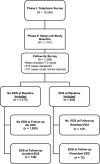Natural history of excessive daytime sleepiness: role of obesity, weight loss, depression, and sleep propensity
- PMID: 25581913
- PMCID: PMC4335535
- DOI: 10.5665/sleep.4488
Natural history of excessive daytime sleepiness: role of obesity, weight loss, depression, and sleep propensity
Abstract
Study objectives: Excessive daytime sleepiness (EDS) is highly prevalent in the general population and is associated with occupational and public safety hazards. However, no study has examined the clinical and polysomnographic (PSG) predictors of the natural history of EDS.
Design: Representative longitudinal study.
Setting: Sleep laboratory.
Participants: From a random, general population sample of 1,741 individuals of the Penn State Adult Cohort, 1,395 were followed up after 7.5 years.
Measurements and results: Full medical evaluation and 1-night PSG at baseline and standardized telephone interview at follow-up. The incidence of EDS was 8.2%, while its persistence and remission were 38% and 62%, respectively. Obesity and weight gain were associated with the incidence and persistence of EDS, while weight loss was associated with its remission. Significant interactions between depression and PSG parameters on incident EDS showed that, in depressed individuals, incident EDS was associated with sleep disturbances, while in non-depressed individuals, incident EDS was associated with increased physiologic sleep propensity. Diabetes, allergy/ asthma, anemia, and sleep complaints also predicted the natural history of EDS.
Conclusions: Obesity, a disorder of epidemic proportions, is a major risk factor for the incidence and chronicity of EDS, while weight loss is associated with its remission. Interestingly, objective sleep disturbances predict incident EDS in depressed individuals, whereas physiologic sleep propensity predicts incident EDS in those without depression. Weight management and treatment of depression and sleep disorders should be part of our public health policies.
Keywords: Daytime sleepiness; depression; incidence; obesity; persistence; polysomnography.
© 2015 Associated Professional Sleep Societies, LLC.
Figures



References
-
- Ohayon MM. Determining the level of sleepiness in the American population and its correlates. J Psychiatr Res. 2012;46:422–7. - PubMed
-
- Foley D, Monjan A, Masaki K, et al. Daytime sleepiness is associated with 3-year incident dementia and cognitive decline in older Japanese-American men. J Am Geriatr Soc. 2001;49:1628–32. - PubMed
Publication types
MeSH terms
Grants and funding
LinkOut - more resources
Full Text Sources
Other Literature Sources
Medical
Molecular Biology Databases

